Ancient and veteran trees (AVTs) stand in our landscapes, watching them dramatically change from medieval times to present day. These natural landmarks store our history and culture, but they are also deeply important for wildlife, keeping our air clean, and helping to store carbon. We are still learning about all the ways in which AVTs support biodiversity and the wider environment, but there is little known about how quickly we are losing these trees and what impact this may have1. This briefing sheet explores the importance of AVTs for landscapes and wildlife, current UK trends, threats, and best practice for management.
What is an ancient or veteran tree?
Ancient and veteran trees are found across the country and can often be seen in farming and countryside landscapes2 with a generally distinct appearance (figure 1), and while there is growing awareness that AVTs are important and of great value3 – it is always good to define what we mean by ‘ancient’ and ‘veteran’.
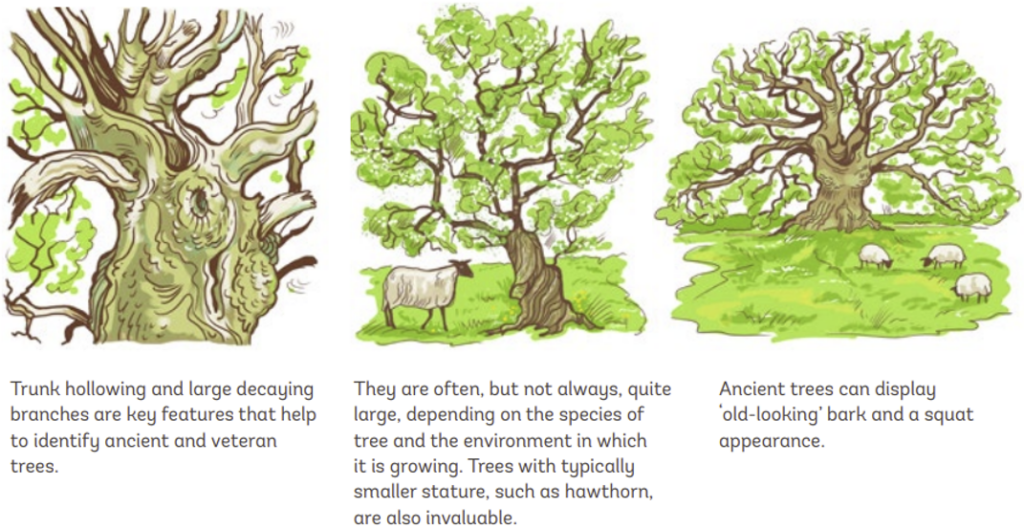
To be ‘ancient’, a tree needs to be notably old for its species and have at least some of the following key features: a low, squat shape; a wide, hollowing trunk; a flattening or downwards growing crown; sap runs and water-filled rot holes; creviced bark; and heart-rot fungi or other fungal fruiting bodies4,5. It can take different amounts of time for a tree to become ancient depending on the species4, with a birch tree potentially being ancient at 150 years old but an oak or yew tree not being considered ancient until they were 400 and 800 years old respectively5.
Veteran trees can be of any age, and although not usually as structurally complex as ancient trees they still have some ancient characteristics that make them valuable5,6. Often veteran trees have survived natural or management-related damage that has accelerated the ageing process6 and helped to create features such as hollows, cavities, broken and decaying branches, as well as creating space for a range of fungi2.
Generally, trunk girth is used to estimate the age of AVTs, but its effectiveness can vary because trees will grow at different rates due to changes in soils, altitude, climate, and tree management – so it can only really be used as a guide4,5. That said, there is a distinction between trees that are large enough to be ancient and those that are not (figure 2).
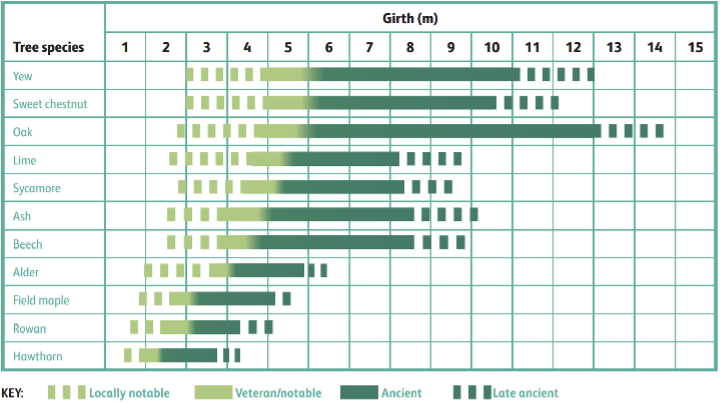
Current UK status
Ancient and veteran trees are in decline globally8 and little is known about the rate of loss in the UK1. Populations of these trees in the UK are of national and international significance1 and are particularly important to protect because they are a finite resource that cannot be replaced by any number of younger trees3,4.
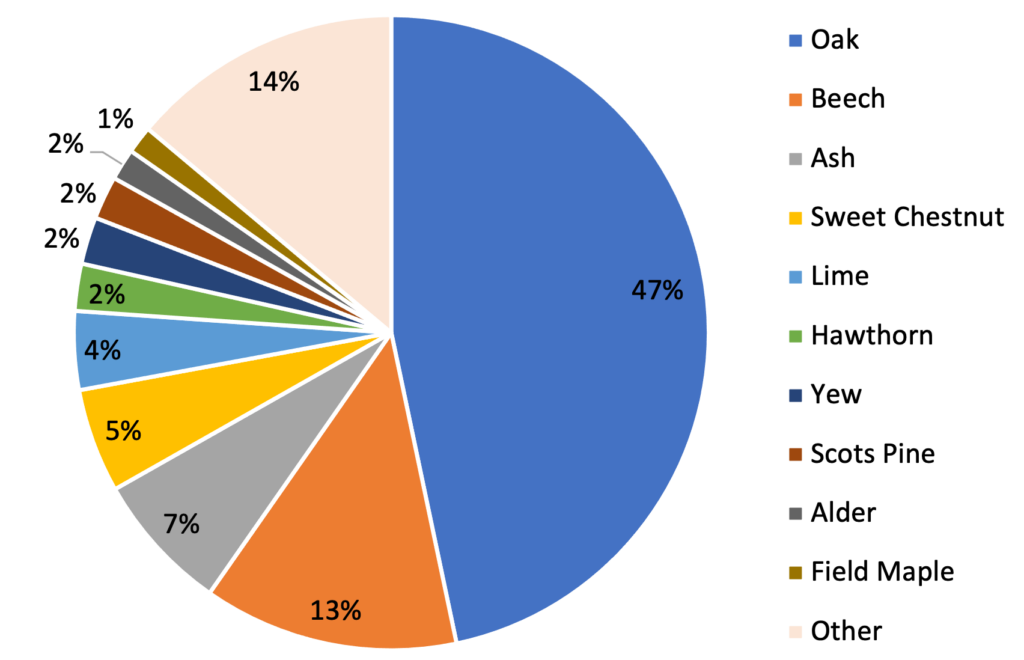
A wide range of species can be ancient or veteran trees, though the time required for each species to reach this status does vary (as seen in figure 2). That said, there are 10 species that are commonly found as AVTs (figure 3), with 60% of these being oak and beech1.
AVTs can be found in a wide range of places, often located in land boundaries, hedgerows, in wooded areas, and near buildings – historically used for fruits, nuts, wood and other tree fodder4. They have been identified in habitats such as wood pastures, parklands, orchards, church grounds and other greenspaces8,9, but are most often found in woodlands and wood pastures (figure 4)1.
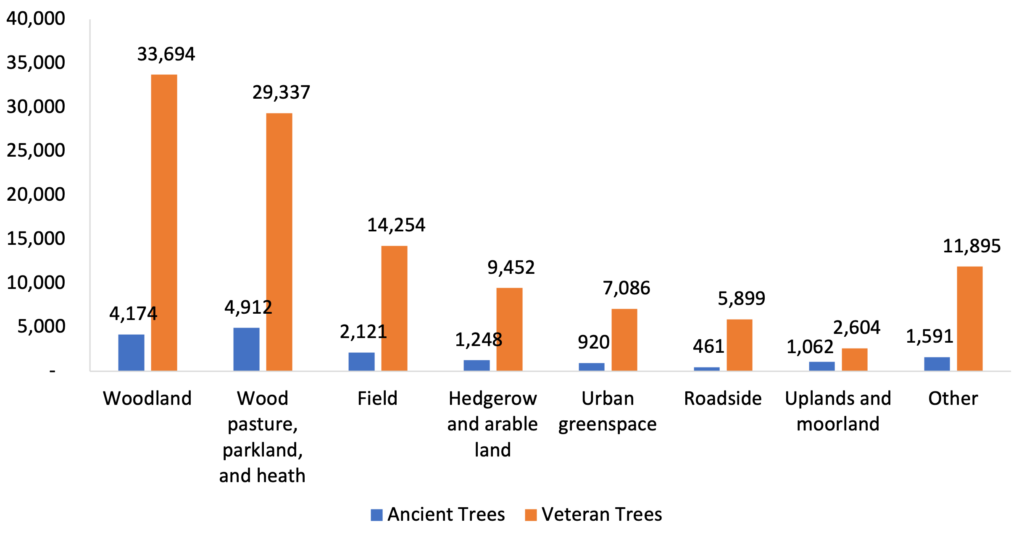
The most recent counts from April 2020 state that there are 14,564 ancient trees and 108,366 veteran trees in the UK, but between 2010 and 2020 a minimum of 73 ancient and 393 veteran trees were lost, including a 1,000 year old oak tree in Offas Dyke, Wales1. These numbers can only be taken as the minimum number of AVTs present and/or lost – this is because the recording body (the Ancient Tree Inventory) relies on volunteers and citizen scientists to make records of trees that may be of veteran or ancient status and because there are more volunteers in some parts of the country than others, it is likely there are AVTs that have not been recorded yet8.
Role in the countryside
Generally, the older the tree, the more valuable it is for biodiversity4,7,10. Because AVTs offer a range of additional features such as large root systems; flaking bark; pockets of water; sap runs; soft, decaying wood matter; and lots of crevices, holes, and hollows – they offer lots of different micro-habitats for all sorts of wildlife to shelter, nest, and live out their life cycles2. This is especially important given that these trees provide what is now a relatively rare habitat3, with oak trees alone thought to support over 2,300 species of birds, bryophytes, fungi, invertebrates, lichens, and mammals11. Lots of these plants and animals are only associated with AVTs and the habitats they offer2,12 and many of these species are also of conservation concern and under threat of extinction13-15. Each stage of rot and decay in AVTs supports a different assemblage of creatures14,16, some of which are being discovered for the first time1.
Over time, lots of invertebrates have evolved alongside ancient trees and have become AVT habitat specialists, and studies show that over 2,000 invertebrates spend some or all of their life cycle in ancient trees in the UK (650 in Ireland)16,17. Species such as bees, beetles, wasps, ants, hoverflies, gnats, slugs, and spiders16 fulfil ecosystem services like pollination and pest control, which can be particularly useful in agricultural landscapes2. Species such as tree bumblebees, social wasps, and hoverflies act as pest control of other invertebrates18, and recent research suggests that the beetles associated with AVTs play an important role in controlling caterpillar numbers17,19. Around 320 species of beetle, bee, wasp, and fly are also known to pollinate spring blossoming trees; fruits such as plums, cherries, apples, and pears; a wide range of flowers; and legumes and other crops18.
Numerous bird species occupy AVTs for nesting and for finding food, with species such as owls, kestrels, marsh tits, treecreepers and nuthatches helping to control flies, spiders, slugs and snails, and caterpillars2,20,21. Mammals such as bats will also make good use of AVTs – particularly species such as Bechstein’s and barbastelle bats – which utilise rot holes, gaps behind bark, and other crevices and cracks for roosting13,22. Some herptiles have also been found using AVT habitats, with great crested newts hibernating in rotting wood and grass snakes using tree hollows for nests23.
AVTs are also home to truly specialist fungi species associated with the specific microhabitats found in them24. These fungi help maintain a healthy cycle of life and death in ecosystems and are often associated with particular tree ages or states of decay25. Mycorrhizal (root-associated) fungi form symbiotic relationships with trees and their roots, helping to provide them with carbon, nitrogen, and potassium as well as maintaining soil health around the tree in return for a share of the trees’ carbohydrates. Many specialist types of saprotrophic (decay-feeding) and saproxylic (in decaying wood) fungi also call AVTs home, helping to consume decaying and dead wood and continue the cycle of nutrients while creating habitats for other species26. Many invertebrates associated with AVTs rely on these fungi to soften wood into digestible materials or to use the fungal fruiting bodies themselves for food or breeding15-17.
In addition to being important ecological resources for biodiversity, ancient and veteran trees also play an important historical and cultural significance in our landscapes, and in many places are tied to the local communities around them2. AVTs are often a central feature in traditional landscapes, and are deeply important for soil health and stability; carbon capture and storage; maintaining strong genetic diversity of botanical species; water retention; microclimate regulation; health and wellbeing; and adding complexity and unique habitat to landscapes2,8-10,19.
Threats
There are many threats facing ancient and veteran trees, which are leading to declines in this rare habitat8. A common problem is inappropriate management, with some trees that used to be managed now left to grow unchecked27 and others cut back or thinned because of public perception of danger, rather than because the tree would benefit from pruning28. This, along with things such as development can lead to the direct loss or damage of AVTs – as a result attempts are often made to try and replace the trees by planting new trees, but this creates a habitat gap while newly planted trees mature and begin to provide the same kinds of habitats8,29.
Intense agriculture can pose another threat for AVTs, mostly in relation to the use of pesticides, fertilisers, and veterinary drugs near the trees; compaction of soils around the trees (for example from machinery); and damage from livestock8,30,31. These factors can cause damage to the trees themselves, the plants and animals that inhabit them, and can also interrupt the trees’ ability to uptake water, nutrients, and spread its roots – which extend further than you might expect (figure 5).
A growing problem for many tree species but particularly for AVTs is the rise in pests and diseases, many of which originate from outside of the UK. These diseases can include everything from rust and mildew to ash dieback, sweet chestnut blight, and plane tree wilt32,33. While some can be relatively mild other pests such the Asian longhorn beetle, citrus longhorn beetle, and oak processionary moth can have a significant negative impact on these trees34-36. Over the years many pests and diseases have been identified, with Observatree, an organisation working with the government, forestry commission, and UK plant health register having identified 22 priority species that are being monitored37.
Climate change is another developing threat to AVTs, with many unknowns when it comes to how these trees will respond to the effects of climate change. The more extreme weather events likely to be seen in the UK such as heavier, prolonged rainfall, flooding, drought, and more severe storms are likely to have different effects on AVTs compared to younger trees. With climate change also comes new pests and diseases, increased stress due to changing climatic conditions, and more frequent damage due to more extreme weather32.
Protection
In the UK, AVTs and other dead and decaying wood are priority habitats and our national planning policy framework states that local planning authorities (LPAs) should refuse any developments that would lead to the loss or deterioration of ‘irreplaceable habitats’ (such as AVTs)38. Despite this these special trees often go unprotected as they have no automatic right of protection2,39, but they are offered protection by the wildlife inhabiting them (such as bats, breeding birds, rare invertebrates, and great crested newts), the places they grow (such as nature/heritage sites, or protected sites such as Sites of Special Scientific Interest or Local/National Nature Reserves), and by things such as tree protection orders (TPOs)39,40.
If a tree is granted a TPO, it becomes an offence to cut down, top, lop, uproot, wilfully damage, or destroy the protected tree and written permission is needed from the LPA before any work that might affect the tree can be completed. Without permission the persons involved could face prosecution and unlimited fines39,40. There are factors such as planning permission or emergency safety works that can override TPOs, but generally once they are in place the LPA has a duty to enforce it39.
More information on AVT protections, designations, and necessary permissions can be found here39, here40, and here9.
Management
NB: The GWCT does not have any specific expertise on AVTs and their management. As such, the following recommendations are based on advice from expert organisations such as the Woodland Trust, the Ancient Tree Forum, Natural England, and Forestry England. These recommendations are not the result of GWCT-led science.
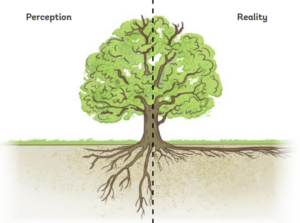
A key part of protecting ancient and veteran trees is ensuring the trees and the land around them is managed sensitively, working to retain these trees and other decaying wood where possible2. There are numerous guides on the management of AVTs2,7,9,41, but there are some key management principles that apply to these trees, particularly within working landscapes.
The first challenge facing landowners and managers is understanding how an ancient or veteran tree may grow in the ground. Roots are often forgotten about when we think of trees, but they are just as important as the trunk, branches, and leaves. You might assume that tree roots grow downwards through the ground, but roots in soil are generally shallower and extend further than is commonly thought2, as shown in figure 5.
Once you have identified any ancient or veteran trees on your land, there are six key things to consider when looking at managing them.
- Prune with care. It can be tempting to try and neaten up trees and their sprawling branches, but this can cause lots of stress for AVTs and remove important habitat. Carefully consider any pruning and leave lower limbs, damaged limbs, and crowns intact unless there is a clear safety issue2. Seek professional advice from an arborist where possible and plan pruning work over a period of years to try and minimise stress to the tree42.
- Control other vegetation. AVTs are known for their epiphytic plant species (plants that grow on other plants) such as lichens, liverworts, mosses, algae which can be a strong force for good, helping to retain nutrients and moisture. Some climbing species such as ivy – although often good for biodiversity – will likely need some maintenance to make sure they do not damage AVTs or restrict their growth7,12.
- Restrict access for grazing animals. Grazing animals can be useful in helping to control vegetation around AVTs, but heavier animals can cause damage to soils, and all can bring excess nutrients to the trees and potentially damage the bark, growth, and epiphytic plant life of the tree. Where possible it is better to try and locate things like supplementary feeding stations, salt licks, and drinking troughs away from AVTs and provide alternative shade with new trees and/or hedgerows2. Intermittent fencing, thorny scrub, or dead wood can also be used to limit where animals can congregate around AVTs7.
- Be mindful of agricultural chemicals. Fungi, terrestrial and soil invertebrates, lichens, and other micro-organisms are important features in and around AVTs but can all be harmed by fertilisers, pesticides, and residues of veterinary medicines43,44. There are several ways to try and reduce the risk to AVTs, such as: avoiding applying substances near tree roots and trunks; using low emission spreading methods; keeping treated animals away from AVTs; keeping slurry and dung away from AVTs; and creating a root protection zone/no-input buffer around the tree (figure 6)2,7.
- Keep machinery out of the way. Heavy machinery, storage of materials, and access routes for vehicles can all contribute to soil compaction and reduce soil pore volume, air availability, and water drainage. This can restrict the air and water available to tree roots, prevent them successfully spreading through soil, and directly damage the roots themselves. This can be avoided by putting a root protection area in place as this keeps access routes, machinery, and stored materials well away from AVTs2. Not operating machinery in wet conditions and keeping the number of trips made near AVTs as minimal as possible can also help – with the first pass of vehicles usually doing the most damage31.
- Avoid disturbing or damaging the soil. Ploughing, digging, ditching and other activities can cause damage to the soil, microorganisms, and root structures of AVTs2,43. Where possible, a root protection area should be placed around the tree – aiming to make it 15 times the diameter of the tree, or 5m from the edge of the canopy if that is a larger area7,9. Care should be given to allow AVTs as much room above and below ground as possible2.
Conclusion
Ancient and veteran trees are very important for water and soil health, historic and cultural significance, aesthetic value, and human wellbeing. They also have great ecological importance – supporting a wide array of specialist animal and plant species and helping manage climate change and pollution. Appropriate management, protection, and acceptance of their significance is the key to keeping AVTs safe for the future. Not enough is currently known about the number and condition of AVTs in the UK, but it is known that they are being lost to poor management, development, and natural events such as storms. As a priority habitat we should do our best to protect AVTs, keeping them in good condition to protect these unique ecosystems for the future.
Addendum: 1st June 2022
An error was made when this article was initially published with ivy being referred to as a parasitic species. Ivy is a climbing species that often uses trees for support, allowing it to reach upwards to better levels of sunlight. It is not a parasitic plant and has a separate root system in the soil, and so absorbs its own nutrients and water as needed. The error has now been corrected within the article, the correct text is as follows:
Some climbing species such as ivy – although often good for biodiversity – will likely need some maintenance to make sure they do not damage AVTs or restrict their growth7,12.
Donate and help us fight misinformation
References
- Reid, C., Hornigold, K., McHenry, E., Nichols, C., Townshead, M., Lewthwaite, K., Elliot, M., Pullinger, R., Hotchkiss, A., Gilmartin, E., White, I., Chesshire, H., Whittle, L., Garthorth, J., Gosling, R., Reed, T. & Hugi, M. (2021). State of the UK’s Woods and Trees 2021. Grantham.
- Woodland Trust & Ancient Tree Forum. (2021). Practical Guidance – Ancient and veteran trees: Caring for special trees on farms.
- Tickell, O. & Thackray, R. (2000). Why the UK’s Ancient Woodland Is Still Under Threat. Grantham.
- Woodland Trust & Ancient Tree Forum. (2015). Ancient Tree Guide no.4: What are ancient, veteran and other trees of special interest?
- Ancient Tree Forum. What are ancient & veteran trees. Available at: https://www.ancienttreeforum.org.uk/ancient-trees/what-are-ancient-veteran-trees/. (Accessed: 10th March 2022)
- Woodland Trust. Veteran trees. Available at: https://ati.woodlandtrust.org.uk/what-we-record-and-why/what-we-record/veteran-trees/. (Accessed: 11th March 2022)
- Lonsdale, D. (2013). Ancient and other veteran trees: further guidance on management. Grantham.
- Nolan, V., Reader, T., Gilbert, F. & Atkinson, N. (2020). The Ancient Tree Inventory: a summary of the results of a 15 year citizen science project recording ancient, veteran and notable trees across the UK. Biodiversity and Conservation, 29:3103–3129.
- Natural England & Forestry Commission. Ancient woodland, ancient trees and veteran trees: advice for making planning decisions. 2022: Available at: https://www.gov.uk/guidance/ancient-woodland-ancient-trees-and-veteran-trees-advice-for-making-planning-decisions. (Accessed: 25th March 2022)
- Woodland Trust & Ancient Tree Forum. (2007). Ancient Tree Guides No.3: Trees and development.
- Mitchell, R.J., Bellamy, P.E., Ellis, C.J., Hewison, R.L., Hodgetts, N.G., Iason, G.R., Littlewood, N.A., Newey, S., Stockan, J.A. & Taylor, A.F.S. (2019). OakEcol: A database of Oak-associated biodiversity within the UK. Data in Brief, 25:
- Ancient Tree Forum. Epiphytes. Available at: https://www.ancienttreeforum.org.uk/ancient-trees/ancient-tree-ecology-wildlife/epiphytes/. (Accessed: 24th March 2022)
- Woodland Trust & Ancient Tree Forum. (2015). Ancient Tree Guide no.6: The Special Wildlife of Trees.
- Alexander, K.N.A. (2011). A review of the national importance and current condition of the saproxylic invertebrate assemblages at Birklands & Bilhaugh Sites of Special Scientific Interest (SSSIs), Sherwood Forest, Nottinghamshire (NECR072). Sheffield.
- Cálix, M., Alexander, K.N.A., Nieto, A., Dodelin, B., Soldati, F., Telnov, D., Vazquez-Albalate, X., Aleksandrowicz, O., Audisio, P., Istrate, P., Jansson, N., Legakis, A., Liberto, A., Makris, C., Merkl, O., Mugerwa Pettersson, R., Schlaghamersky, J., Bologna, M.A., Brustel, H., Buse, J., Novák, V. & L., P. (2018). European Red List of Saproxylic Beetles. Brussels, Belgium.
- Ancient Tree Forum. Invertebrates. Available at: https://www.ancienttreeforum.org.uk/ancient-trees/ancient-tree-ecology-wildlife/invertebrates/. (Accessed: 24th March 2022)
- Alexander, K.N.A. (2002). The invertebrates of living & decaying timber in Britain and Ireland – A provisional annotated checklist (No. 467 – English Nature Research Reports). Peterborough, England.
- Falk, S. (2021). A review of the pollinators associated with decaying wood, old trees and tree wounds in Great Britain.
- Wetherbee, R., Birkemoe, T. & Sverdrup-Thygeson, A. (2020). Veteran trees are a source of natural enemies. Scientific Reports, 10:
- Mols, C.M.M. & Visser, M.E. (2002). Great tits can reduce caterpillar damage in apple orchards. Journal of Applied Ecology, 39:888–889.
- Ancient Tree Forum. Birds. Available at: https://www.ancienttreeforum.org.uk/ancient-trees/ancient-tree-ecology-wildlife/birds/. (Accessed: 24th March 2022)
- Ancient Tree Forum. Mammals. Available at: https://www.ancienttreeforum.org.uk/ancient-trees/ancient-tree-ecology-wildlife/mammals/. (Accessed: 24th March 2022)
- Ancient Tree Forum. Amphibians & reptiles. Available at: https://www.ancienttreeforum.org.uk/ancient-trees/ancient-tree-ecology-wildlife/amphibians-reptiles/. (Accessed: 24th March 2022)
- Humphrey, J.W., Sippola, A.-L., Lemperiere, G., Dodelin, B., Alexander, K.N.A. & Butler, J.E. (2004). Deadwood as an Indicator of Biodiversity in European Forests: From Theory to Operational Guidance. In: Monitoring and Indicators of Forest Biodiversity in Europe – From Ideas to Operationality, EFI Proceedings No. 51, 2004: 51:193–206. (ed. Marchetti, M.) European Forest Institute. Florence, Italy.
- Schuck, A., Meyer, P., Menke, N., Lier, M. & Lindner, M. (2004). Forest Biodiversity Indicator: Dead Wood – A Proposed Approach towards Operationalising the MCPFE Indicator. In: Monitoring and Indicators of Forest Biodiversity in Europe – From Ideas to Operationality, EFI Proceedings No. 51, 2004: 49–78. (ed. Marchetti, M.) European Forest Institute. Florence, Italy.
- Ancient Tree Forum. Fungi. Available at: https://www.ancienttreeforum.org.uk/ancient-trees/ancient-tree-ecology-wildlife/fungi/. (Accessed: 24th March 2022)
- Ancient Tree Forum. Poor tree management. Available at: https://www.ancienttreeforum.org.uk/ancient-trees/threats-to-ancient-trees/lack-of-care-and-poor-management/. (Accessed: 24th March 2022)
- Ancient Tree Forum. Health and safety concerns. Available at: https://www.ancienttreeforum.org.uk/ancient-trees/threats-to-ancient-trees/health-and-safety-concerns/. (Accessed: 24th March 2022)
- Ancient Tree Forum. A lack of trees for the future. Available at: https://www.ancienttreeforum.org.uk/ancient-trees/threats-to-ancient-trees/a-lack-of-trees-for-the-future/. (Accessed: 24th March 2022)
- Ancient Tree Forum. Farming activities. Available at: https://www.ancienttreeforum.org.uk/ancient-trees/threats-to-ancient-trees/farming/. (Accessed: 24th March 2022)
- Hamza, M.A. & Anderson, W.K. (2005). Soil compaction in cropping systems: A review of the nature, causes and possible solutions. Soil and Tillage Research, 82:121–145.
- Woodland Trust & Ancient Tree Forum. (2015). Ancient Tree Guide no.5: Trees and climate change.
- Ancient Tree Forum. Pests & diseases. Available at: https://www.ancienttreeforum.org.uk/ancient-trees/threats-to-ancient-trees/pests-and-diseases/. (Accessed: 28th March 2022)
- Observatree. Oak Processionary Moth. Available at: https://www.observatree.org.uk/pests-and-diseases/priority-pests-and-diseases/oak-processionary-moth/. (Accessed: 4th April 2022)
- Observatree. Citrus Longhorn Beetle. Available at: https://www.observatree.org.uk/pests-and-diseases/priority-pests-and-diseases/citrus-longhorn-beetle/. (Accessed: 4th April 2022)
- Observatree. Asian Longhorn Beetle. Available at: https://www.observatree.org.uk/pests-and-diseases/priority-pests-and-diseases/asian-longhorn-beetle/. (Accessed: 4th April 2022)
- Observatree. Priority pests and diseases. Available at: https://www.observatree.org.uk/pests-and-diseases/priority-pests-and-diseases/. (Accessed: 28th March 2022)
- Historic England. (2021). Veteran Trees. Available at: https://historicengland.org.uk/advice/technical-advice/parks-gardens-and-landscapes/veteran-trees/. (Accessed: 25th March 2022)
- Woodland Trust. What protection do ancient trees have? Available at: https://ati.woodlandtrust.org.uk/what-we-record-and-why/why-we-record/ancient-tree-protection/. (Accessed: 28th April 2022)
- Ancient Tree Forum. Legal protection. Available at: https://www.ancienttreeforum.org.uk/ancient-trees/protecting-ancient-and-veteran-trees/legal-protection/. (Accessed: 28th March 2022)
- Read, H. (2000). Veteran Trees: A guide to good management. English Nature.
- National Tree Safety Group. Common sense risk management of trees: Landowner summary of guidance on trees and public safety in the UK for estates and smallholdings.
- Ancient Tree Forum. Fields. Available at: https://www.ancienttreeforum.org.uk/ancient-trees/british-treescapes/fields/. (Accessed: 23rd March 2022)
- Gunstone, T., Cornelisse, T., Klein, K., Dubey, A. & Donley, N. (2021). Pesticides and Soil Invertebrates: A Hazard Assessment. Frontiers in Environmental Science, 9: